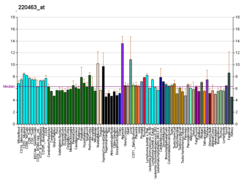TRPM3
Appearance
Transient receptor potential cation channel subfamily M member 3 is a protein that in humans is encoded by the TRPM3 gene.[5]
Template:PBB Summary TRPM3 was shown to be activated by the neurosteroid pregnenolone sulphate in pancreatic beta cell. The activation causes calcium influx and subsequent insulin release, therefore it is suggested that TRPM3 modulates glucose homeostasis.[6]
See also
References
- ^ a b c GRCh38: Ensembl release 89: ENSG00000083067 – Ensembl, May 2017
- ^ a b c GRCm38: Ensembl release 89: ENSMUSG00000052387 – Ensembl, May 2017
- ^ "Human PubMed Reference:". National Center for Biotechnology Information, U.S. National Library of Medicine.
- ^ "Mouse PubMed Reference:". National Center for Biotechnology Information, U.S. National Library of Medicine.
- ^ Clapham DE, Julius D, Montell C, Schultz G (Dec 2005). "International Union of Pharmacology. XLIX. Nomenclature and structure-function relationships of transient receptor potential channels". Pharmacol Rev. 57 (4): 427–50. doi:10.1124/pr.57.4.6. PMID 16382100.
- ^ Wagner TF, Loch S, Lambert S, et al. (November 2008). "Transient receptor potential M3 channels are ionotropic steroid receptors in pancreatic beta cells". Nature Cell Biology. 10 (12): 1421–30. doi:10.1038/ncb1801. PMID 18978782.
Further reading
- Oberwinkler J, Phillipp SE (2007). "TRPM3". Handb Exp Pharmacol. 179 (179): 253–67. doi:10.1007/978-3-540-34891-7_15. PMID 17217062.
- Harteneck C, Reiter B (2007). "TRP channels activated by extracellular hypo-osmoticity in epithelia". Biochem. Soc. Trans. 35 (Pt 1): 91–5. doi:10.1042/BST0350091. PMID 17233610.
External links
- TRPM3+protein,+human at the U.S. National Library of Medicine Medical Subject Headings (MeSH)
This article incorporates text from the United States National Library of Medicine, which is in the public domain.







